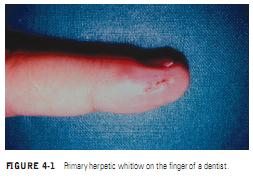There are approximately 600,000 new cases of primary HSV infections per year in the United States. Primary HSV infection occurs in patients who do not have immunity resulting from previous contact with the virus. HSV is contracted after intimate contact with an individual who has active HSV primary or recurrent lesions. Primary HSV may also be spread by asymptomatic shedders with HSV present in salivary secretions. The majority of oral HSV infections is caused by HSV1, but primary oral HSV2 infections may also occur chiefly as a result of oral-genital contact.
Infection of the fingers (herpetic whitlows) of health professionals may occur during treatment of infected patients. Dentists may experience primary lesions of the fingers from contact with lesions of the mouth or saliva of patients who are asymptomatic carriers of HSV, although the incidence of this disorder should be minimal if gloves are worn (Figure 4-1).
Use of gloves should also prevent the spread of HSV from the fingers of health care workers infected with herpetic whitlows to patients.
Primary HSV infection of the newborn was previously believed to be caused by direct contact with vaginal HSV lesions during birth, but it has now been established that a majority of mothers giving birth to children with primary HSV are asymptomatic carriers without lesions.These infections of the newborn result in viremia and disseminated infection of the brain, liver, adrenals, and lungs.
Primary HSV infection of the newborn was previously believed to be caused by direct contact with vaginal HSV lesions during birth, but it has now been established that a majority of mothers giving birth to children with primary HSV are asymptomatic carriers without lesions.These infections of the newborn result in viremia and disseminated infection of the brain, liver, adrenals, and lungs.
Newborns of mothers with antibody titers are protected by placentally transferred antibodies during the first 6 months of life. After 6 months of age, the incidence of primary HSV1 infection increases. The incidence of primary HSV1 infection reaches a peak between 2 and 3 years of age. Incidence of primary HSV2 infection does not increase until the age when sexual activity begins. Studies of neutralizing and complement-fixing antibodies to HSV have shown a continual rise in the percentage of patients who have had contact with the virus until 60 years of age, demonstrating that although the primary infection with HSV1 is chiefly a disease of infants and children, new cases continue to appear during adult life. This is consistent with the many reports of adults with primary herpetic gingivostomatitis.
The incidence of primary herpes infection has been shown to vary according to socioeconomic group. In lower socioeconomic groups, 70 to 80% of the population have detectable antibodies to HSV by the second decade of life, indicating prior HSV infection, whereas, in a group of middle class individuals, only 20 to 40% of the patients in the same age group have evidence of contact with HSV.
21,22
A significant percentage of cases of primary herpes are subclinical, although the apparently low incidence of a history of classic primary herpetic gingivostomatitis is also influenced by the young age of patients who develop the infection, by the improper diagnosis of some cases, and by the cases of primary herpetic pharyngitis that cannot be clinically distinguished from other causes of viral pharyngitis.
The incidence of primary herpes infection has been shown to vary according to socioeconomic group. In lower socioeconomic groups, 70 to 80% of the population have detectable antibodies to HSV by the second decade of life, indicating prior HSV infection, whereas, in a group of middle class individuals, only 20 to 40% of the patients in the same age group have evidence of contact with HSV.
21,22
A significant percentage of cases of primary herpes are subclinical, although the apparently low incidence of a history of classic primary herpetic gingivostomatitis is also influenced by the young age of patients who develop the infection, by the improper diagnosis of some cases, and by the cases of primary herpetic pharyngitis that cannot be clinically distinguished from other causes of viral pharyngitis.
